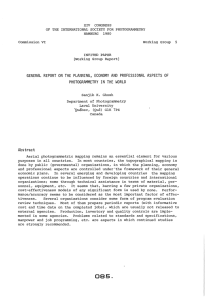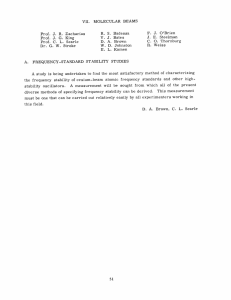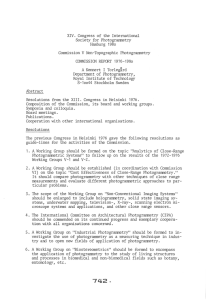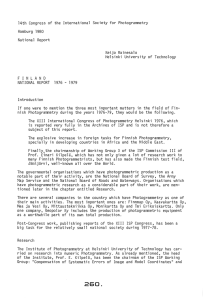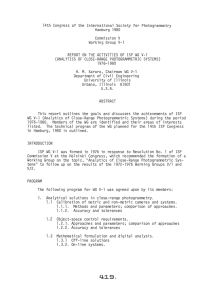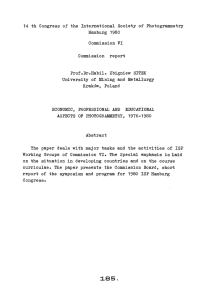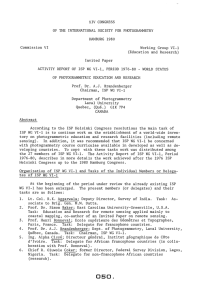14TH CONGRESS OF THE INTERNATIONAL ... HAlffiURG 1980 Commission III Working Group VI-2:
advertisement
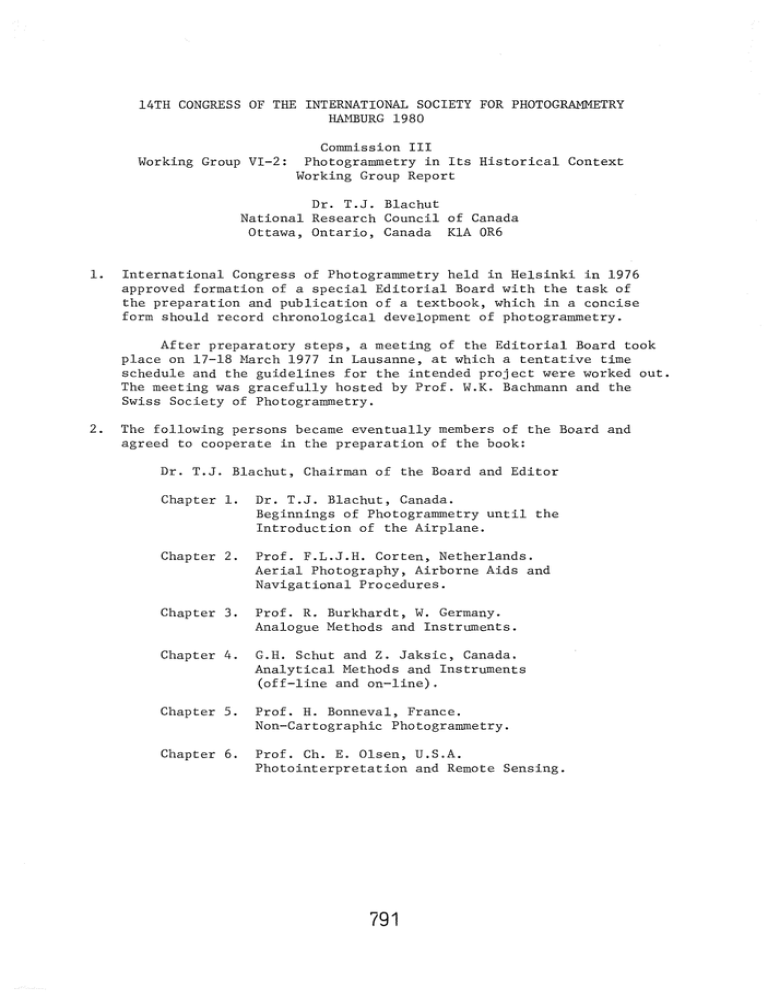
14TH CONGRESS OF THE INTERNATIONAL SOCIETY FOR PHOTOGRAMMETRY HAlffiURG 1980 Working Group VI-2: Commission III Photogrammetry in Its Historical Context Working Group Report Dr. T.J. Blachut National Research Council of Canada Ottawa, Ontario, Canada KlA OR6 1. International Congress of Photogrammetry held in Helsinki in 1976 approved formation of a special Editorial Board with the task of the preparation and publication of a textbook, which in a concise form should record chronological development of photograrnrnetry. After preparatory steps, a meeting of the Editorial Board took place on 17-18 ~~rch 1977 in Lausanne, at which a tentative time schedule and the guidelines for the intended project were worked out. The meeting was gracefully hosted by Prof. W.K. Bachmann and the Swiss Society of Photograrnrnetry. 2. The following persons became eventually members of the Board and agreed to cooperate in the preparation of the book: Dr. T.J. Blachut, Chairman of the Board and Editor Chapter 1. Dr. T.J. Blachut, Canada. Beginnings of Photograrnrnetry until the Introduction of the Airplane. Chapter 2. Prof. F.L.J.H. Corten, Netherlands. Aerial Photography, Airborne Aids and Navigational Procedures. Chapter 3. Prof. R. Burkhardt, W. Germany. Analogue Methods and Instruments. Chapter 4. G.H. Schut and Z. Jaksic, Canada. Analytical Methods and Instruments (off-line and on-line). Chapter 5. Prof. H. Bonneval, France. Non-Cartographic Photograrnrnetry. Chapter 6. Prof. Ch. E. Olsen, U.S.A. Photointerpretation and Remote Sensing. 791 Chapter 7. Dr. F. Doyle, U.S.A. Photogrammetry in Mapping Earth and Universe (Satellite Photogrammetry). Chapter 8. Prof. K. Rinner, Austria. Significance and Future Role of Photogrammetry. Chapter 9. Dr. B. Dubuisson, France. Synoptic Tables Correlating Various Events. The following persons are members ex officio or invited members of the Board: Mr. J. Cruset, President ISP, ex officio Prof. Z. Sitek, President Comm. VI, Poland, ex officio Prof. L. Solaini, ISP Past President, Italy - invited 3. The Chairman of the Board sent out, in 1977, a letter to all member societies of the ISP with a request for cooperation and source material that could be of interest to the authors of the book. The received material was distributed among authors concerned. Particularly valuable information concerning early times of photogrammetry was received from British, French, German and Italian Societies. 4. The Chairman tried to organize some financial support indispensable for the preparation of the manuscript and the publication of the book. Strongly supported by the ISP President, Mr. Cruset and the Canadian Section of UNESCO, the Chairman submitted an application and together with the ISP President visited UNESCO headquarters in Paris. Moreover, support of the submission by national sections of some Latin American countries was organized. However, these efforts failed since until now no response was obtained from UNESCO. 5. The Chairman suggested also, to the ISP President, a campaign among larger national photogrammetric societies and various industries with the purpose of providing some funds for the project. He was asked, however, not to approach industries because of other ISP plans and considerations. Also, individual efforts of Drs. F. Doyle in the U.S.A., G. Konecny in F.R.G. and of myself in Canada, were to no avail, with the exception of a small donation from Canadian Marconi Company. In this situation the ISP council decided to support the project with three yearly installments of $7000 each. 792 6. It must be realized that production of the kind of a book we are working on is very complex and expensive. In contrast to usual texts, authors must carefully refer to original sources of information, mostly locally not available; some of the manuscripts must be translated into English, an expert draftsman must be hired to secure uniform illustrations throughout the book, linguistic and technical editing, retyping of manuscripts, etc., require paid professional help, in addition to the effort and facilities provided without charge by individual co-authors. 7. As the work progressed it became necessary to define more precisely the character and the scope of the book. The publishers with whom a tentative contract was established warned against a too large size of the book, which would make the book commercially unattractive and thus jeopardize its publication. Since the authors tended towards a concise and a compact presentation it was decided that the book should present chronological development of photogrammetric methods and instruments concentrating on main events and achievements with sufficient reference to source material. By taking this approach, the book should become a concise history of our discipline, but at the same time a very valuable textbook providing information not available in current manuals. 8. To review the progress in the preparation of the book and various accompanying problems, a meeting of the European members of the Editorial Board was organized in Bonn, on 3 August 1979, in which participated T.J. Blachut, F.L.J.H. Corten, B. Dubuisson and K. Rinner. 9. It is unfortunate (though not unexpected) that the progress in the preparation of the book differs with the individual authors some of whom could not meet the time schedule because of the understandable pressure of other work and circumstances. More regrettable, G.H. Schut reversed his initial and subsequent decisions and announced at this late moment abandonment of the project. In the meantime I was advised by the following authors that they completed their chapters: Prof. K. Rinner- text has been edited, retyped and is available for further processing Prof. R. Burkhardt - text completed and is being translated into English Prof. H. Bonneval - text completed and is being reviewed by invited persons Dr. T.J. Blachut - "freezing" of the text requires careful consultation with source material not available in Canada. 793 The remaining authors assured me that they will try to complete their texts as soon as possible and I am trying to gain over a competent author to prepare a half-chapter on "Analytical Hethods". 10. The book due to its unique content will no doubt fill the gap in the photogrammetric literature and could become important to many linguistic groups not endowed in satisfactory photogrammetric textbooks. It is therefore suggested that the manuscript, once completed, should be offered for translation and publication in other languages than English. My first contact in this regard, with the Pan American Institute of Geography and History, concerning the possibility of Spanish edition, seems to be promising. 11. Only those who have experience with the preparation and publication of complex texts in a voluntary, multipurpose, international joint effort realize the difficulty of the task. Of course the main objective is to produce a high quality book which could be regarded as a lasting contribution. If the price of such an achievement is a certain delay in the execution of the project, the price is negligible indeed and it must be accepted. There is little choice anyway, since the group of authors have no effective control over the individual members with the exception of their own sense of responsibility towards their own commitment and towards a certain fairplay as a basis of a joint effort. It is in the recognition of the most constructive attitude of my distinguished Colleagues and coauthors as a group that I would like to express them my sincere appreciation. I would also like to thank other members of the Editorial Board for their help and cooperation. Last, but not least I would like to thank the ISP President, ISP Council and the President of Commission VI for their cooperation and willingness to bridge the occasional differences of opinion in a constructive manner. 794




